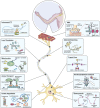Genetics of amyotrophic lateral sclerosis: seeking therapeutic targets in the era of gene therapy
- PMID: 35691950
- PMCID: PMC9968660
- DOI: 10.1038/s10038-022-01055-8
Genetics of amyotrophic lateral sclerosis: seeking therapeutic targets in the era of gene therapy
Abstract
Amyotrophic lateral sclerosis (ALS) is an intractable disease that causes respiratory failure leading to mortality. The main locus of ALS is motor neurons. The success of antisense oligonucleotide (ASO) therapy in spinal muscular atrophy (SMA), a motor neuron disease, has triggered a paradigm shift in developing ALS therapies. The causative genes of ALS and disease-modifying genes, including those of sporadic ALS, have been identified one after another. Thus, the freedom of target choice for gene therapy has expanded by ASO strategy, leading to new avenues for therapeutic development. Tofersen for superoxide dismutase 1 (SOD1) was a pioneer in developing ASO for ALS. Improving protocols and devising early interventions for the disease are vital. In this review, we updated the knowledge of causative genes in ALS. We summarized the genetic mutations identified in familial ALS and their clinical features, focusing on SOD1, fused in sarcoma (FUS), and transacting response DNA-binding protein. The frequency of the C9ORF72 mutation is low in Japan, unlike in Europe and the United States, while SOD1 and FUS are more common, indicating that the target mutations for gene therapy vary by ethnicity. A genome-wide association study has revealed disease-modifying genes, which could be the novel target of gene therapy. The current status and prospects of gene therapy development were discussed, including ethical issues. Furthermore, we discussed the potential of axonal pathology as new therapeutic targets of ALS from the perspective of early intervention, including intra-axonal transcription factors, neuromuscular junction disconnection, dysregulated local translation, abnormal protein degradation, mitochondrial pathology, impaired axonal transport, aberrant cytoskeleton, and axon branching. We simultaneously discuss important pathological states of cell bodies: persistent stress granules, disrupted nucleocytoplasmic transport, and cryptic splicing. The development of gene therapy based on the elucidation of disease-modifying genes and early intervention in molecular pathology is expected to become an important therapeutic strategy in ALS.
© 2022. The Author(s).
Conflict of interest statement
The authors declare no competing interests.
Figures



References
Publication types
MeSH terms
Substances
Supplementary concepts
Grants and funding
LinkOut - more resources
Full Text Sources
Other Literature Sources
Medical
Miscellaneous
